Land transport

Land transport is the transport or movement of people, animals or goods from one location to another location on land. This is in contrast with other main types of transport such as maritime transport and aviation. The two main forms of land transport can be considered to be rail transport and road transport.
Systems
Several systems of land transport have been devised, from the most basic system of humans carrying things from place to sophisticated networks of ground-based transportation utilising different types of vehicles and infrastructure. The three types are human-powered, animal powered and machine powered
Human-powered transportation

Human-powered transport, a form of
Although humans are able to walk without infrastructure, the transport can be enhanced through the use of roads, especially when using the human power with vehicles, such as bicycles and
Animal-powered transportation
Animal-powered transport is the use of working animals for the movement of people and goods. Humans may ride some of the animals directly, use them as pack animals for carrying goods, or harness them, alone or in teams, to pull sleds or wheeled vehicles.
Road transportation
A road is an identifiable
The most common road vehicle is the
Automobiles offer high flexibility and with low capacity, but are deemed with high energy and area use, and the main source of noise and air pollution in cities; buses allow for more efficient travel at the cost of reduced flexibility.[5] Road transport by truck is often the initial and final stage of freight transport.
Rail transportation
Rail transport is where a
A train consists of one or more connected vehicles that run on the rails. Propulsion is commonly provided by a
Other modes
Cable transport is a broad mode where vehicles are pulled by cables instead of an internal power source. It is most commonly used at steep gradient. Typical solutions include aerial tramway, elevators, escalator and ski lifts; some of these are also categorized as conveyor transport.
Connections with other modes
Airports
Airports serve as a terminus for air transport activities, but most people and cargo transported by air must use ground transport to reach their final destination.
Several major airports, including Denver International and JFK International, provide many types of ground transportation, often by working with livery companies and similar businesses. Smaller airports might only have a few private rental companies and a bus service. Larger airports tend to offer several different transportation options. Larger airports also sometimes have light rail and/or roads that loop around an airport to provide access from multiple terminals.
Seaports
As with air transport, sea transport typically requires use of ground transport at either end of travel for people and goods to reach their final destinations. Significant infrastructure is used at ports to transfer people and goods between sea and land systems.
Elements
Infrastructure
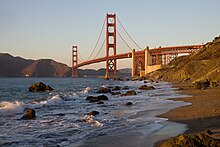
Infrastructure is the fixed installations that allow a vehicle to operate. It consists of a way, a terminal and facilities for parking and maintenance. For rail, pipeline, road and cable transport, the entire way the vehicle travels must be built up.
Terminals such as stations are locations where passengers and freight can be transferred from one vehicle or mode to another. For passenger transport, terminals are integrating different modes to allow riders to interchange to take advantage of each mode's advantages. For instance, airport rail links connect airports to the city centers and suburbs. The terminals for automobiles are parking lots, while buses and coaches can operate from simple stops.[7] For freight, terminals act as transshipment points, though some cargo is transported directly from the point of production to the point of use.
The
Vehicles

A vehicle is any non-living device that is used to move people and goods. Unlike the infrastructure, the vehicle moves along with the cargo and riders. Unless being pulled by a cable or muscle-power, the vehicle must provide its own propulsion; this is most commonly done through a steam engine, combustion engine, or electric motor, though other means of propulsion also exist. Vehicles also need a system of converting the energy into movement; this is most commonly done through wheels, propellers and pressure.
Vehicles are most commonly staffed by a driver. However, some systems, such as people movers and some rapid transits, are fully automated. For passenger transport, the vehicle must have a compartment for the passengers. Simple vehicles, such as automobiles, bicycles or simple aircraft, may have one of the passengers as a driver.
Users
Public
Public land transport refers to carriage of people and goods by government or commercial entities which is made available to the public at large for the purpose of facilitating the economy and society they serve. Most transport infrastructure and large transport vehicles are operated in this manner. Funds to pay for such transport may come from
Commerce
Commercial land transport refers to carriage of people and goods by commercial entities made available at cost to individuals, businesses, and the government for the purpose of profiting the entities providing the travel. Most infrastructure used is publicly owned, and vehicles tend to be large and efficient to maximize capacity and profit margins. Freight shipping and long-distance travel are common uses served by commercial land transport.
Military
Military land transport refers to carriage of people and goods by the military or other operators for the purpose of supporting military operations, both in peacetime as well as in combat areas. Such activity may use a combination of public infrastructure as well as military-specific infrastructure and in many cases is designed to operate with little or no infrastructure when necessary. Vehicles can range from basic commercial or even private vehicles to those specifically designed for military use.
Private
Private land transport refers to individuals and organizations transporting themselves and their own people, animals, and goods at their own discretion. Vehicles used are typically smaller, though publicly owned infrastructure is often used for travel.
Function
Relocation of travelers and cargo are the most common uses of transport. However, other uses exist, such as the strategic and tactical
Passenger


Passenger transport, or travel, is divided into public and private transport. Public transport is scheduled services on fixed routes, while private is vehicles that provide ad hoc services at the riders desire. The latter offers better flexibility, but has lower capacity, and a higher environmental impact. Travel may be as part of daily commuting, for business, leisure or migration.
Short-haul transport is dominated by the automobile and mass transit. The latter consists of
Taxis and buses can be found on both ends of the public transport spectrum. Buses are the cheaper mode of transport but are not necessarily flexible, and taxis are very flexible but more expensive. In the middle is demand-responsive transport, offering flexibility whilst remaining affordable.
Freight
Freight transport, or shipping, is a key in the

Bulk transport is common with cargo that can be handled roughly without deterioration; typical examples are ore, coal, cereals and petroleum. Because of the uniformity of the product, mechanical handling can allow enormous quantities to be handled quickly and efficiently. The low value of the cargo combined with high volume also means that economies of scale become essential in transport, and whole trains are commonly used to transport bulk. Liquid products with sufficient volume may also be transported by pipeline.
History
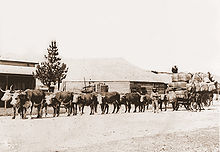
Humans' first means of land transport was walking. The domestication of animals introduces a new way to lay the burden of transport on more powerful creatures, allowing heavier loads to be hauled, or humans to ride the animals for higher speed and duration. Inventions such as the wheel and sled helped make animal transport more efficient through the introduction of vehicles. However, water transport, including rowed and sailed vessels, was the only efficient way to transport large quantities or over large distances prior to the Industrial Revolution.
The first forms of
The Industrial Revolution in the 19th century saw a number of inventions fundamentally change transport. With telegraphy, communication became instant and independent of transport. The invention of the steam engine, closely followed by its application in rail transport, made land transport independent of human or animal muscles. Both speed and capacity increased rapidly, allowing specialization through manufacturing being located independent of natural resources.
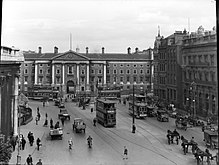
With the development of the combustion engine and the automobile at the turn into the 20th century, road transport became more viable, allowing the introduction of mechanical private transport. The first highways were constructed during the 19th century with macadam. Later, tarmac and concrete became the dominant paving material.
After World War II, the automobile and airlines took higher shares of transport, reducing rail to freight and short-haul passenger.[15] In the 1950s, the introduction of containerization gave massive efficiency gains in freight transport, permitting globalization.[14] International air travel became much more accessible in the 1960s, with the commercialization of the jet engine. Along with the growth in automobiles and motorways, this introduced a decline for rail transport. After the introduction of the Shinkansen in 1964, high-speed rail in Asia and Europe started taking passengers on long-haul routes from airlines.[15]
Early in
Impact
Economic
Transport is a key necessity for
Modern society dictates a physical distinction between home and work, forcing people to transport themselves to places of work or study, as well as to temporarily relocate for other daily activities. Passenger transport is also the essence of tourism, a major part of recreational transport. Commerce requires the transport of people to conduct business, either to allow face-to-face communication for important decisions or to move specialists from their regular place of work to sites where they are needed.
Planning
Transport planning allows for high utilization and less impact regarding new infrastructure. Using models of
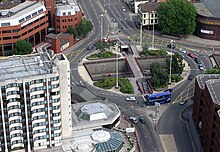
Because of the negative impacts made, transport often becomes the subject of controversy related to choice of mode, as well as increased capacity. Automotive transport can be seen as a tragedy of the commons, where the flexibility and comfort for the individual deteriorate the natural and urban environment for all. Density of development depends on mode of transport, with public transport allowing for better spatial utilization. Good land use keeps common activities close to people's homes and places higher-density development closer to transport lines and hubs, to minimize the need for transport. There are economies of agglomeration. Beyond transportation some land uses are more efficient when clustered. Transportation facilities consume land, and in cities, pavement (devoted to streets and parking) can easily exceed 20 percent of the total land use. An efficient transport system can reduce land waste.
Too much infrastructure and too much smoothing for maximum vehicle throughput means that in many cities there is too much traffic and many—if not all—of the negative impacts that come with it. It is only in recent years that traditional practices have started to be questioned in many places, and as a result of new types of analysis which bring in a much broader range of skills than those traditionally relied on—spanning such areas as environmental impact analysis, public health, sociologists as well as economists—the viability of the old mobility solutions is increasingly being questioned. European cities are leading this transition.
Environment
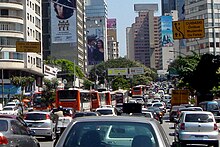
| Part of a series on |
| Pollution |
|---|
 |
Transport is a major use of
Other environmental impacts of transport systems include
See also
- Transport
- Public transport
- Fuel efficiency in transportation
- List of emerging transportation technologies
- Outline of transport
- IEEE Intelligent Transportation Systems Society
- Journal of Transport and Land Use
References
- ^ "Major Roads of the United States". United States Department of the Interior. 2006-03-13. Archived from the original on 13 April 2007. Retrieved 24 March 2007.
- ^ "Road Infrastructure Strategic Framework for South Africa". National Department of Transport (South Africa). Archived from the original on 27 September 2007. Retrieved 24 March 2007.
- ^ Lay, 1992: 6–7[full citation needed]
- ^ "What is the difference between a road and a street?". Word FAQ. Lexico Publishing Group. 2007. Retrieved 24 March 2007.
- ^ Cooper et al., 1998: 278[full citation needed]
- ^ Cooper et al., 1998: 279[full citation needed]
- ^ Cooper et al., 1998: 275–76[full citation needed]
- S2CID 154699038.
- ^ Chopra & Meindl 2007, p. 3.
- ^ Chopra & Meindl 2007, pp. 63–64.
- ^ Chopra & Meindl 2007, p. 54.
- ^ Bardi, Coyle & Novack 2006, p. 4.
- ^ Bardi, Coyle & Novack 2006, p. 473.
- ^ a b Bardi, Coyle & Novack 2006, pp. 211–214.
- ^ a b Cooper et al., 1998: 277[full citation needed]
- ^ Clifford Winston, Last Exit: Privatization and Deregulation of the U.S. Transportation System (Washington, D.C.: Brookings Institution, 2010).
- ISBN 978-0-415-15310-2.
- ^ PMID 18180450.
- ^ Worldwatch Institute (16 January 2008). "Analysis: Nano Hypocrisy?". Archived from the original on 13 October 2013. Retrieved 15 February 2014.
- ^ "Claverton-Energy.com". Claverton-Energy.com. 2009-02-17. Retrieved 2010-05-23.
- ^ Data on the barriers and motivators to more sustainable transport behaviour is available in the UK Department for Transport study "Climate Change and Transport Choices Archived 2011-05-30 at the Wayback Machine" published in December 2010.
- Environment Canada. "Transportation". Archived from the originalon July 13, 2007. Retrieved 30 July 2008.
Works
- Bardi, Edward J.; Coyle, John Joseph; Novack, Robert A. (2006). Management of Transportation. Thomson/South-Western. ISBN 978-0-324-31443-4.
- Chopra, Sunil; Meindl, Peter (2007). Supply Chain Management: Strategy, Planning, and Operation. Pearson Prentice Hall. ISBN 978-0-13-173042-7.
